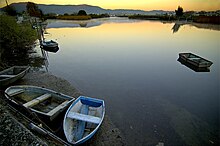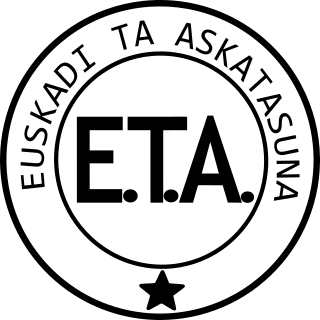
ETA, an acronym for Euskadi Ta Askatasuna, was an armed Basque nationalist and far-left separatist organization in the Basque Country between 1959 and 2018, with its goal being independence for the region. The group was founded in 1959 during the era of Francoist Spain and later evolved from a pacifist group promoting traditional Basque culture to a violent paramilitary group engaged in a campaign of bombings, assassinations, and kidnappings throughout Spain and especially in the Southern Basque Country against the regime which was highly centralised and hostile to any sort of identities that wasn't Castilian-centric. ETA was the main group within the Basque National Liberation Movement and was the most important Basque participant in the Basque conflict.
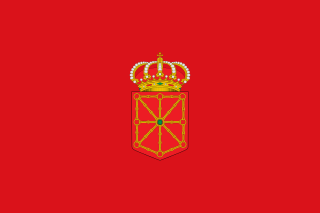
Navarre, officially the Chartered Community of Navarre, is a landlocked foral autonomous community and province in northern Spain, bordering the Basque Autonomous Community, La Rioja, and Aragon in Spain and Nouvelle-Aquitaine in France. The capital city is Pamplona. The present-day province makes up the majority of the territory of the medieval Kingdom of Navarre, a long-standing Pyrenean kingdom that occupied lands on both sides of the western Pyrenees, with its northernmost part, Lower Navarre, located in the southwest corner of France.

The Ertzaintza, is the autonomous police force for the Basque Country, largely replacing the Spanish Policía Nacional and Guardia Civil. An Ertzaintza member is called an ertzaina.
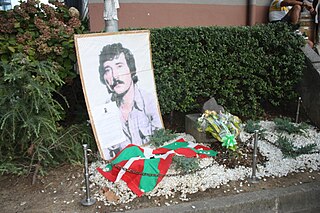
GAL were death squads illegally established by officials of the Spanish government to fight against ETA, the principal Basque separatist militant group. They were active from 1983 to 1987 under Spanish Socialist Workers' Party (PSOE)-led governments.

On December 30, 2006, a van bomb exploded in the Terminal 4 parking area at the Madrid–Barajas Airport in Spain, killing two and injuring 52. On January 9, 2007, the Basque nationalist and separatist organisation ETA claimed responsibility for the attack. The attack, one of the most powerful carried out by ETA, damaged the airport terminal and destroyed the entire parking structure. The bombing ended a nine-month ceasefire declared by the armed organisation and prompted the government to halt plans for negotiations with the organisation. Despite the attack, ETA claimed that the ceasefire was still in place and regretted the death of civilians. The organisation eventually announced the end of the ceasefire in June 2007.
ETA's 2006 "permanent ceasefire" was the period spanning between 24 March and 30 December 2006 during which, following an ETA communiqué, the Spanish government, led by José Luis Rodríguez Zapatero on one side, and the militant group on the other, engaged in talks as a means to agree on a formula to voluntarily disband the latter. It was terminated as a result of the 2006 Madrid Barajas International Airport bombing.
The 2009 Palma Nova bombing occurred on July 30, 2009, when a limpet bomb went off outside a Civil Guard barracks in the town of Palma Nova, Majorca, Spain. The bomb was placed under a patrol car and two Civil Guard officers died as a result of the explosion. A second device was found under another Civil Guard vehicle at nearby barracks and safely exploded by police. On August 9, the Basque nationalist and separatist organisation ETA claimed responsibility for the attack, while four other bombs exploded around restaurants and shopping centres in Palma, Majorca, causing no injuries.

The Basque conflict, also known as the Spain–ETA conflict, was an armed and political conflict from 1959 to 2011 between Spain and the Basque National Liberation Movement, a group of social and political Basque organizations which sought independence from Spain and France. The movement was built around the separatist organization ETA, which had launched a campaign of attacks against Spanish administrations since 1959. ETA had been proscribed as a terrorist organization by the Spanish, British, French and American authorities at different moments. The conflict took place mostly on Spanish soil, although to a smaller degree it was also present in France, which was primarily used as a safe haven by ETA members. It was the longest running violent conflict in modern Western Europe. It has been sometimes referred to as "Europe's longest war".

A van bomb went off on 19 May 2008 outside a boat club in the town of Getxo, Biscay in the Basque Country, Spain. The attack caused serious damage to the club, as well as nearby buildings and structures. No one was killed or injured after a warning call from the Basque separatist organisation ETA. On 31 May, the organisation claimed responsibility for the bombing.

The 1980 Ispaster attack was a gun and grenade attack by the Basque separatist organisation ETA which occurred on 1 February 1980 near the Basque town of Ispaster. The targets were a convoy of civil guards who were escorting workers and weapons from the nearby Esperanza y Cia Arms factory to Bilbao. A total of six civil guards were killed, while two ETA members were killed by hand grenades that they had thrown. The attack was the deadliest of 1980, the year when ETA killed more people than any other.
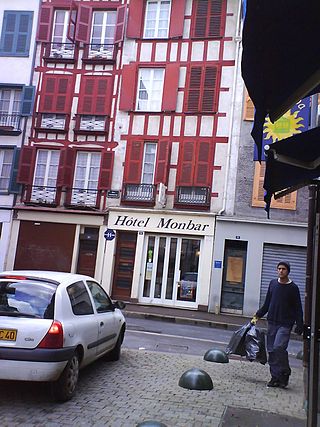
The Monbar Hotel attack was carried out by the Grupos Antiterroristas de Liberación (GAL), a Spanish state-sponsored death squad, on 25 September 1985 in Bayonne, Pyrénées-Atlantiques, France. The targets were four members of the Basque separatist terrorist group Euskadi Ta Askatasuna (ETA), whom the Spanish government believed to be senior figures in the organization, itself proscribed as a terrorist group in Spain and France. All four people were killed, with a fifth person, apparently unconnected to ETA, injured in the shooting. This represented the deadliest attack carried out by the GAL. Although two of the participants were apprehended shortly after the shooting, controversy surrounded the possible involvement of senior figures in the Spanish police.
The assassination of Augusto Unceta Barrenechea was an attack by the Basque separatist group ETA which took place on 8 October 1977 in Guernica in the Basque Country in northern Spain.
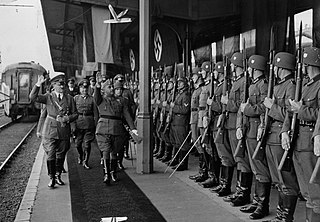
World War II in the Basque Country refers to the period extending from 1940 to 1945. It affected the French Basque Country, but also bordering areas across the Pyrenees on account of the instability following the end of the Spanish Civil War, and the friendly ties between Germany, Vichy France, and the triumphant Spanish military dictatorship.

The last use of capital punishment in Spain took place on 27 September 1975 when two members of the armed Basque nationalist and separatist group ETA political-military and three members of the Revolutionary Antifascist Patriotic Front (FRAP) were executed by firing squads after having been convicted and sentenced to death by military tribunals for the murder of policemen and civil guards. Spain was Western Europe's only dictatorship at the time and had been unpopular and internationally isolated in the post-war period due to its relations with Nazi Germany in the 1930s and 1940s and the fact that its autocratic leader, Francisco Franco, had come to power by overthrowing a democratically elected government. As a result, the executions resulted in substantial criticism of the Spanish government, both domestically and abroad. Reactions included street protests, attacks on Spanish embassies, international criticism of the Spanish government and diplomatic measures, such as the withdrawal of the ambassadors of fifteen European countries.

The Segovia prison break occurred in Segovia, Spain on 5 April 1976 when 29 political prisoners escaped from Segovia prison. This was the largest prison break in Spain since the Spanish Civil War. The prisoners escaped by means of tunnels they had excavated and then through the prison's drainage system. Hidden in a truck, they fled in the direction of the French border. Before reaching the border, their escape plans broke down and they found themselves stranded and lost in woodland in Navarre. Most of them were recaptured after a confrontation with the Civil Guards in Espinal, during which one of the prisoners was shot dead. The remaining four escapees managed to cross the French border and were detained by the French government, but escaped once again. In 1977, the Spanish authorities declared a general amnesty, after which the escapees were freed or could return to Spain.

Women in ETA in Francoist Spain were few in numbers, and portrayed as dangerous by the media. Euskadi Ta Askatasuna (ETA) grew out of a Basque nationalist movement with roots that pre-dated the Second Spanish Republic. When Franco seized power, the new regime cracked down on Basque nationalism, imprisoned and killed many activists and made traditional women's activism difficult to continue. Women found themselves being investigated by the new regime. Basque nationalists began to stockpile weaponry following the end of World War II. ETA was created in 1952 by students in Bilbao, creating a fissure in the Basque nationalist community by the mid-1950s. Their attitude towards women was patriarchal and informed by their conservative Roman Catholicism. There would be few women in the movement in this period.

Women in the Basque Nationalist Party in Francoist Spain were involved in leadership positions from an early period. The Basque Nationalist Party (PNV) was founded prior to the Second Spanish Republic in Bilbao, as a conservative Roman Catholic organization. They initially tried to be neutral during the Civil War, but later more openly opposed Nationalist forces. This led to repression and investigation after the war of women PNV members, and wives and daughters of male PNV members. Emakume Abertzale Batza, PNV's women political section, was operated in exile in this early period.

Elvire De Greef,, code name Tante Go or Auntie Go, was a member of the Comet Escape Line in World War II. From her house in Anglet in southwestern France, near the border with Spain, she led efforts by the Comet Line in the Basque country to exfiltrate people from occupied Belgium through France to Spain, especially Allied airmen whose aircraft had been shot down by Nazi Germany. Once across the border in neutral Spain the escapees were transported to the United Kingdom. De Greef's husband and two teenage children also worked with the Comet line.
Florentino Goikoetxea (1898–1980) was a Basque who worked for the Comet Escape Line during World II. A smuggler by profession, he guided more than 200 Allied airmen shot down in occupied Belgium and France over the Pyrenees mountains to neutral Spain from where they could be repatriated to the United Kingdom. He was honored with the George Medal from the United Kingdom and the Legion of Honor from France.
